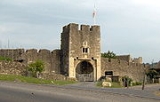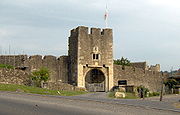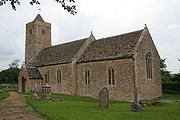
Farleigh Hungerford
Encyclopedia
Farleigh Hungerford is a village within the civil parish
of Norton St Philip
in Somerset
, England, 9 miles southeast of Bath, 3½ miles west of Trowbridge
on A366, in the valley of the River Frome
.
Within this small village are the notable ruins of Farleigh Hungerford Castle
, which played a significant part in the English Civil War
. Evidence has also been found of occupation during Roman
times; the foundations of a villa were excavated in a field just north west of the castle in 1822.
The village is the venue for the annual Trowbridge Village Pump Festival
.
soldiers whose family held it only for about a quarter of a century. In 1369 AD Sir Thomas de Hungerford bought the house from the childless daughter of the recently deceased squire, and the house later came to be known as Farleigh Hungerford. The parish of Farleigh Hungerford was part of the Wellow
Hundred.
 It is the location of Farleigh Hungerford Castle
It is the location of Farleigh Hungerford Castle
, built around 1370 and owned by English Heritage
and the former home of Sir Thomas Hungerford, Speaker
of the House of Commons
. In the early 15th century, his son, Sir Walter Hungerford
, enlarged the castle by adding the outer court that enclosed the parish church, St Leonard's, which he used as his chapel. It is thought that he built the present parish church nearby to replace it.
In the Civil War
, Sir Edward Hungerford
(1596-1648) commanded the Parliamentary forces of Wiltshire
briefly. His half-brother, Col John Hungerford, was a Royalist and was given the command of the garrison of Farleigh in 1644. However he surrendered to Sir Edward without fighting in 1645. A later Sir Edward Hungerford (1632-1711), who had been MP for Chippenham during Richard Cromwell
's brief reign, entertained Charles II of England
at Farleigh in about 1675. After the discovery of the Rye House Plot
in 1683, the castle was raided by the government and weapons were seized. The spendthrift Sir Edward was the last male of his family, but by the time of his death he had already sold the castle (in 1686) to Henry Bayntun for £56,000.
Enclosed by a curtain wall with a cylindrical tower at each corner, the squarish inner bailey
contained a selection of domestic buildings. Today only two of the towers and some sections of the curtain wall survive. The south west tower stands almost to its full height of five storeys in places, but the south east tower exists only a little more than its third floor. It is a grade I listed building.
is a large country house, previously the centre of the Farleigh Hungerford estate, and has sometimes been called Farleigh New Castle. The present building was started in the 18th century but is mainly an early 19th century Gothic Revival building. In 2010 it was converted to be used as the offices and training centre of Bath Rugby
.
 The Anglican parish church of St Leonard was consecrated in 1443 and remodelled in 1856. It was once within the outer walls of the castle but is now separated from it by the main road. The church, which is a grade II* listed building, has a perpendicular style
The Anglican parish church of St Leonard was consecrated in 1443 and remodelled in 1856. It was once within the outer walls of the castle but is now separated from it by the main road. The church, which is a grade II* listed building, has a perpendicular style
West Tower in 3 stages, with a pair of stone gargoyle
s on each face. There are the remains of some 14th-century stained glass
in the north window of the nave
and in the east Chancel window which are of Flemish
origin. The church also contains a 17th-century wooden altar rail carved with open work scrolls and figures. The pulpit dates from the early 18th century and is carved with eagles and angels.
Civil parish
In England, a civil parish is a territorial designation and, where they are found, the lowest tier of local government below districts and counties...
of Norton St Philip
Norton St Philip
Norton St Philip is a village in Somerset, England, located between the City of Bath and the town of Frome. The village is in the district of Mendip, and the parliamentary constituency of Somerton and Frome....
in Somerset
Somerset
The ceremonial and non-metropolitan county of Somerset in South West England borders Bristol and Gloucestershire to the north, Wiltshire to the east, Dorset to the south-east, and Devon to the south-west. It is partly bounded to the north and west by the Bristol Channel and the estuary of the...
, England, 9 miles southeast of Bath, 3½ miles west of Trowbridge
Trowbridge
Trowbridge is the county town of Wiltshire, England, situated on the River Biss in the west of the county, approximately 12 miles southeast of Bath, Somerset....
on A366, in the valley of the River Frome
River Frome, Somerset
The River Frome is a river in Somerset. It rises near Witham Friary, flows north through the town of Frome and joins the River Avon at Freshford, south of Bath....
.
Within this small village are the notable ruins of Farleigh Hungerford Castle
Farleigh Hungerford Castle
Farleigh Hungerford Castle, sometimes called Farleigh Castle or Farley Castle, is a medieval castle in Farleigh Hungerford, Somerset, England. The castle was built in two phases: the inner court was constructed between 1377 and 1383 by Sir Thomas Hungerford, who made his fortune working as a...
, which played a significant part in the English Civil War
English Civil War
The English Civil War was a series of armed conflicts and political machinations between Parliamentarians and Royalists...
. Evidence has also been found of occupation during Roman
Ancient Rome
Ancient Rome was a thriving civilization that grew on the Italian Peninsula as early as the 8th century BC. Located along the Mediterranean Sea and centered on the city of Rome, it expanded to one of the largest empires in the ancient world....
times; the foundations of a villa were excavated in a field just north west of the castle in 1822.
The village is the venue for the annual Trowbridge Village Pump Festival
Trowbridge Village Pump Festival
Village Pump FestivalStarted over 30 years ago in a barn at the lamb Inn Trowbridge, it then moved to Stowford Manor Farm, Farleigh Hungerford, England...
.
History
The manor was called Farleigh Montfort from just after the conquest when it was owned by a Norman family, the Montforts, until the fourteenth century. Then Reginald de Montfort sold the estate to one of Edward III’sEdward III of England
Edward III was King of England from 1327 until his death and is noted for his military success. Restoring royal authority after the disastrous reign of his father, Edward II, Edward III went on to transform the Kingdom of England into one of the most formidable military powers in Europe...
soldiers whose family held it only for about a quarter of a century. In 1369 AD Sir Thomas de Hungerford bought the house from the childless daughter of the recently deceased squire, and the house later came to be known as Farleigh Hungerford. The parish of Farleigh Hungerford was part of the Wellow
Wellow (hundred)
The Hundred of Wellow is one of the 40 historical Hundreds in the ceremonial county of Somerset, England, dating from before the Norman conquest during the Anglo-Saxon era although exact dates are unknown. Each hundred had a 'fyrd', which acted as the local defence force and a court which was...
Hundred.

Farleigh Hungerford Castle
Farleigh Hungerford Castle, sometimes called Farleigh Castle or Farley Castle, is a medieval castle in Farleigh Hungerford, Somerset, England. The castle was built in two phases: the inner court was constructed between 1377 and 1383 by Sir Thomas Hungerford, who made his fortune working as a...
, built around 1370 and owned by English Heritage
English Heritage
English Heritage . is an executive non-departmental public body of the British Government sponsored by the Department for Culture, Media and Sport...
and the former home of Sir Thomas Hungerford, Speaker
Speaker of the British House of Commons
The Speaker of the House of Commons is the presiding officer of the House of Commons, the United Kingdom's lower chamber of Parliament. The current Speaker is John Bercow, who was elected on 22 June 2009, following the resignation of Michael Martin...
of the House of Commons
British House of Commons
The House of Commons is the lower house of the Parliament of the United Kingdom, which also comprises the Sovereign and the House of Lords . Both Commons and Lords meet in the Palace of Westminster. The Commons is a democratically elected body, consisting of 650 members , who are known as Members...
. In the early 15th century, his son, Sir Walter Hungerford
Walter Hungerford, 1st Baron Hungerford
Walter Hungerford, 1st Baron Hungerford KG was an English knight, landowner, from 1400 to 1414 Member of the House of Commons, of which he became Speaker, then was an Admiral and peer....
, enlarged the castle by adding the outer court that enclosed the parish church, St Leonard's, which he used as his chapel. It is thought that he built the present parish church nearby to replace it.
In the Civil War
English Civil War
The English Civil War was a series of armed conflicts and political machinations between Parliamentarians and Royalists...
, Sir Edward Hungerford
Edward Hungerford (roundhead)
Sir Edward Hungerford , parliamentarian; eldest son of Sir Anthony Hungerford of Black Bourton; K.B., 1625; High Sheriff of Wiltshire, 1631; M.P., Chippenham, 1620, and in Short Parliament and the Long Parliament. Colonel of a regiment in the Parliamentary army. Occupied and plundered Salisbury in...
(1596-1648) commanded the Parliamentary forces of Wiltshire
Wiltshire
Wiltshire is a ceremonial county in South West England. It is landlocked and borders the counties of Dorset, Somerset, Hampshire, Gloucestershire, Oxfordshire and Berkshire. It contains the unitary authority of Swindon and covers...
briefly. His half-brother, Col John Hungerford, was a Royalist and was given the command of the garrison of Farleigh in 1644. However he surrendered to Sir Edward without fighting in 1645. A later Sir Edward Hungerford (1632-1711), who had been MP for Chippenham during Richard Cromwell
Richard Cromwell
At the same time, the officers of the New Model Army became increasingly wary about the government's commitment to the military cause. The fact that Richard Cromwell lacked military credentials grated with men who had fought on the battlefields of the English Civil War to secure their nation's...
's brief reign, entertained Charles II of England
Charles II of England
Charles II was monarch of the three kingdoms of England, Scotland, and Ireland.Charles II's father, King Charles I, was executed at Whitehall on 30 January 1649, at the climax of the English Civil War...
at Farleigh in about 1675. After the discovery of the Rye House Plot
Rye House Plot
The Rye House Plot of 1683 was a plan to assassinate King Charles II of England and his brother James, Duke of York. Historians vary in their assessment of the degree to which details of the conspiracy were finalized....
in 1683, the castle was raided by the government and weapons were seized. The spendthrift Sir Edward was the last male of his family, but by the time of his death he had already sold the castle (in 1686) to Henry Bayntun for £56,000.
Enclosed by a curtain wall with a cylindrical tower at each corner, the squarish inner bailey
Motte-and-bailey
A motte-and-bailey is a form of castle, with a wooden or stone keep situated on a raised earthwork called a motte, accompanied by an enclosed courtyard, or bailey, surrounded by a protective ditch and palisade...
contained a selection of domestic buildings. Today only two of the towers and some sections of the curtain wall survive. The south west tower stands almost to its full height of five storeys in places, but the south east tower exists only a little more than its third floor. It is a grade I listed building.
Farleigh House
Farleigh HouseFarleigh House
Farleigh House is a large country house in the English county of Somerset that was formerly the centre of the Farleigh Hungerford estate, and much of the stone came from Farleigh Hungerford Castle.The house is a Grade II listed building....
is a large country house, previously the centre of the Farleigh Hungerford estate, and has sometimes been called Farleigh New Castle. The present building was started in the 18th century but is mainly an early 19th century Gothic Revival building. In 2010 it was converted to be used as the offices and training centre of Bath Rugby
Bath Rugby
Bath Rugby is an English professional rugby union club that is based in the city of Bath. They play in the Aviva Premiership league...
.
Church of St Leonard

English Gothic architecture
English Gothic is the name of the architectural style that flourished in England from about 1180 until about 1520.-Introduction:As with the Gothic architecture of other parts of Europe, English Gothic is defined by its pointed arches, vaulted roofs, buttresses, large windows, and spires...
West Tower in 3 stages, with a pair of stone gargoyle
Gargoyle
In architecture, a gargoyle is a carved stone grotesque, usually made of granite, with a spout designed to convey water from a roof and away from the side of a building thereby preventing rainwater from running down masonry walls and eroding the mortar between...
s on each face. There are the remains of some 14th-century stained glass
Stained glass
The term stained glass can refer to coloured glass as a material or to works produced from it. Throughout its thousand-year history, the term has been applied almost exclusively to the windows of churches and other significant buildings...
in the north window of the nave
Nave
In Romanesque and Gothic Christian abbey, cathedral basilica and church architecture, the nave is the central approach to the high altar, the main body of the church. "Nave" was probably suggested by the keel shape of its vaulting...
and in the east Chancel window which are of Flemish
County of Flanders
The County of Flanders was one of the territories constituting the Low Countries. The county existed from 862 to 1795. It was one of the original secular fiefs of France and for centuries was one of the most affluent regions in Europe....
origin. The church also contains a 17th-century wooden altar rail carved with open work scrolls and figures. The pulpit dates from the early 18th century and is carved with eagles and angels.

